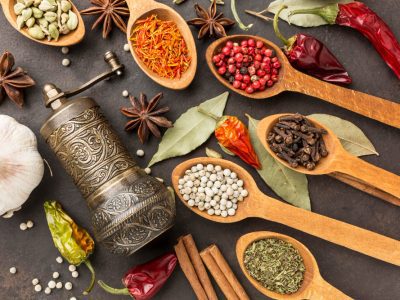While much of the world has been busy figuring out how to get their hands on the next great sushi joint, Indian food has quietly taken over. From street carts to fine dining establishments and everything in between, Indian food rules. If you’ve ever wondered why such a diverse and delicious cuisine has taken over our palates — and stomachs — let us explain:
Spices, spices and more spices.

Indian food is known for its abundance of spices. But these ingredients aren’t just thrown into a dish to make it look pretty or taste good: they’re used to help bring out the flavours of other ingredients, add colour and texture and even create unique-tasting dishes.
The main reason for using so many spices in Indian cuisine is that they have different properties which complement each other well. For example, cumin seeds are spicy and hot; ginger has a sweet flavour. Turmeric is bitter and has anti-inflammatory properties. Garlic is sharp but milder than onions (which have a much stronger flavour). Add all these with oil or ghee, along with some more delicate flavours like lemon juice or freshly grated coconut, and you have an amazing combination of tastes!
The holy trinity: Onion, garlic and ginger.
You are probably familiar with the holy trinity of Indian cooking: onion, garlic and ginger. They’re a vital part of just about every Indian dish, whether you’re eating curry or tandoori chicken. These three ingredients you use in a variety of ways. While onions you can chop raw or fried until dark brown and crispy in a tempering, garlic you can roast whole before being ground into a paste with fresh ginger to make garam masala. One of India’s most popular spice mixes — while the juice from unpeeling cloves can also flavour tomato sauces when they’re simmering together with tomatoes until soft and flavorful.
In addition to their unmistakable flavour profiles, these ingredients all possess unique health benefits that make them ideal for use in your kitchen at home: Onions contain antioxidants which help fight off heart disease by lowering blood pressure and reducing cholesterol levels. Garlic contains allicin which has been shown to lower blood pressure as well as reduce cholesterol levels. Ginger has antiseptic properties that cleanse your digestive tract while also improving circulation throughout the body by breaking down fat cells within our bodies.
The dal dilemma.

Dal is a staple of Indian food, so you’ll want to know what’s in it. There are many kinds of dal—some are thick and creamy, while others are thin and soupy. The main ingredient in all types is lentils (or pulses), which come in a variety of colours, sizes, and textures. They’re rich in protein, fibre, iron, potassium, magnesium and even calcium!
A quick word on chillies.
Chillies, along with spices and herbs, are one of the most important ingredients in Indian cuisine.
There are wide varieties available to you. The most popular include:
- Cayenne pepper: Adds flavour and heat; not very spicy. It can be used fresh or dried.
- Red pepper flakes: Adds flavour and heat; medium spicy level when used fresh or dried. If you like really spicy food, you’re probably looking for a different kind of chilli altogether!
- Chipotle peppers: Adds smoky flavour without much heat. You can find these canned in adobo sauce or dried whole at speciality stores like Whole Foods Market (or your local grocery store). They’re also easy to grow yourself if you have access to some sunlight!
Indian food rules the world because of its unique flavours
Indian food rules the world because of its unique flavours, you can create using our unique ingredients! To understand how Indian food is so delicious, you must first start by understanding what makes it so special. Most Indians use an array of spices and herbs in their cooking – from cumin seed to saffron flower petals, ginger to cardamom pods, turmeric root to kokum. You cannot find anywhere else in the world. These spices lend a distinct “Indian” flavour to everything they touch.
The holy trinity: of onion, garlic, and ginger play a vital role in creating this distinctive taste profile as well – one cannot imagine Indian cuisine without them! Dal (lentils) you can cook with any number of pulses like moong or masoor along with onions, garlic and ginger for amazing results every time you make them at home or order them out at an Indian restaurant or street food stall around town!
You may hear stories about people getting chillies stuck up their noses when eating chilli-rich foods like Vindaloo curry. However, if someone were to tell me “chili-less Vindaloo is bland”, chilli does not make up all of its flavours (just read through this list again). It’s like saying coffee without sugar tastes awful – it doesn’t make sense, does it?

Conclusion
We hope this guide has given you a better understanding of the ingredients that make Indian food so delicious. We know it’s not easy to find Indian recipes or ingredients in your local supermarket, but there are plenty of online resources that can help!
















